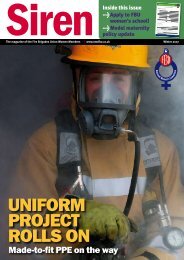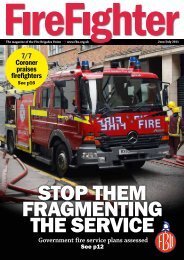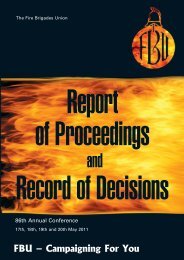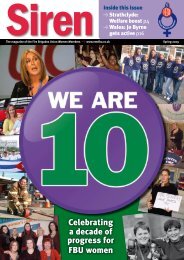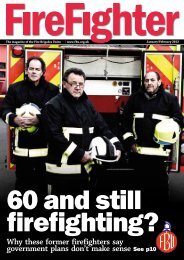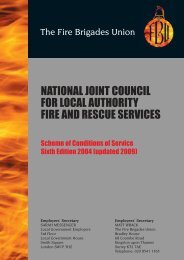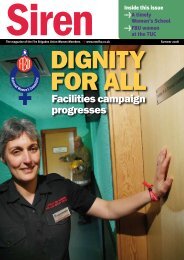Draft London Safety Plan 2010/2013 - Fire Brigades Union London
Draft London Safety Plan 2010/2013 - Fire Brigades Union London
Draft London Safety Plan 2010/2013 - Fire Brigades Union London
You also want an ePaper? Increase the reach of your titles
YUMPU automatically turns print PDFs into web optimized ePapers that Google loves.
We will however need to set our target for the total<br />
number of visits carried out a little higher than this as<br />
there will be occasions where we want to deliver home<br />
fire safety visits to those who may not be at the greatest<br />
risk, but where we can bring additional benefits.<br />
Examples of these visits include visits where, after a<br />
serious fire, we will campaign in the local vicinity of the<br />
fire and where we work in partnership with other<br />
organisations to help achieve wider benefits for the<br />
community.<br />
To achieve our ambition would mean that by 2015/16,<br />
around 74,000 visits a year would be carried out by our<br />
staff or our partners in high risk areas, or to high risk<br />
individuals<br />
Proposed changes to the start and finish times of our<br />
operational shifts are intended to release additional<br />
productive working time from the day shift. We expect to<br />
release three additional productive hours each day and<br />
some of this time will be used to meet our increased<br />
delivery targets.<br />
FIRE SAFETY REGULATION<br />
In July 2009, six people died in the worst domestic fire in<br />
<strong>London</strong> in recent years. The full repercussions of this fire<br />
will probably take some time to materialise, but the<br />
Authority is already aware of a higher level of scrutiny on<br />
fire safety regulatory responsibilities and on risk<br />
assessment processes.<br />
<strong>Fire</strong> safety regulation applies to virtually all buildings,<br />
places and structures, other than individual private<br />
dwellings. Figures from the Valuation Office Agency<br />
suggest that the Authority has enforcement<br />
responsibilities for over 570,000 premises. Of these, up to<br />
334,000 are premises where it is calculated that both the<br />
Housing Acts and the Regulatory Reform (<strong>Fire</strong> <strong>Safety</strong>)<br />
Order (the fire safety order) apply. In addition to these,<br />
there is an unknown number of premises of mixed<br />
commercial and residential use.<br />
The Authority’s fire safety regulatory responsibility is to<br />
ensure that building owners and occupiers and those that<br />
manage buildings comply with fire safety laws. This<br />
means:<br />
<br />
<br />
<br />
seeking to influence those responsible for designing<br />
buildings so that, as far as possible, fire safety<br />
measures, such as sprinklers, are installed in<br />
buildings where the risk justifies it;<br />
influencing those who make fire safety laws;<br />
providing advice and guidance to the business<br />
community and others on how they can comply with<br />
the law and also proving general fire safety advice;<br />
and<br />
<br />
the proportionate use of enforcement powers,<br />
including prosecution, where it is appropriate.<br />
There are not sufficient resources to inspect every<br />
building subject to fire safety law in <strong>London</strong> and the<br />
legislation never envisaged that there would be. We<br />
therefore tailor our inspection programme to target those<br />
buildings which pose the greatest risk to safety from fire.<br />
TARGETING BUILDINGS MOST AT RISK<br />
We have an extensive database of information about the<br />
risk in buildings, gathered from fire safety audits and<br />
inspections, fire investigation and operational activities.<br />
We combine this information with the local knowledge of<br />
fire safety officers and firefighters working in local<br />
communities to prioritise our inspection programme.<br />
Using this information, we aim to focus our regulatory<br />
inspections and resources towards those buildings<br />
where:<br />
<br />
<br />
<br />
there is the greatest risk of fire occurring;<br />
the most casualties and most significant<br />
consequences occur if a fire does happen; and<br />
where our regulatory advice makes a significant<br />
improvement to the overall safety of the building.<br />
For example, the risk to life from a fire in a residential care<br />
home where people sleep and also may have mobility or<br />
mental health problems is higher than the risk in an office<br />
where people are awake and the number of people with<br />
mobility issues is usually much lower.<br />
Once audited, premises are given a risk score which takes<br />
into account the premises use, the quality of the general<br />
fire precautions measures in place and the management<br />
of the premises. Re-inspection of premises is also<br />
prioritised on the basis of risk but as the premises have<br />
previously been audited, the priority given also takes into<br />
account the level of risk identified by the risk score for the<br />
premises.<br />
High rise blocks of flats do fall within one of the higher<br />
relative risk levels (when compared, for example, to<br />
offices). But because there are very specific<br />
responsibilities placed upon housing authorities and<br />
because there are regimes in place for the inspection and<br />
assessment of local authority performance, LFEPA’s<br />
inspection programme does not prioritise the inspection<br />
of the majority of the housing sector except for mixed<br />
commercial/residential use). This approach is consistent<br />
with Better Regulation guidance from the government<br />
and also the findings of the Hampton Report into local<br />
authority enforcement practice.<br />
In addition to the risk- based audit and re-inspection<br />
programme, fire safety officers will attend and audit<br />
premises to which the fire safety Order applies if there<br />
21





